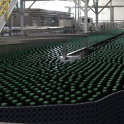|
RiggenBlaque posted:I've been using the same 2 aluminum pots for the last 3 years, so I'm not too worried about cost
|
|
|
|

|
| # ? May 15, 2024 06:35 |
|
Thanks! I'm fortunate enough to have a brewery store within walking distance. I'm sure I can find something along those lines that isn't bleach. I did add some yeast nutrient; next time I won't add the extra water. I was instructed to do that in order to minimize the amount of oxygen on top and prevent it from turning into vinegar. I did skip boiling the honey: I only boiled the water, which was distilled water from jugs. I added the water to the honey when the former was down to about 160 degrees Fahrenheit. It takes a long time for that much water to cool without an icebath or something. I might be able to add more honey, but I don't think I will, as they honey I've been using was in two individually-sealed gallon tubs, and I have since moved far away from the apiary where I acquired it. I'm saving the other tub for my second attempt.
|
|
|
|
Warheart525 posted:Thanks! We used to have a huge mead thread, but it also pops up in here occasionally. It sounds like whoever gave you the instructions didn't quite know what they were doing. Fortunately it seems like you did most everything right with the exception of filling up the primary bucket all the way. You need that head space during primary so it doesn't overflow and make a mess. I'd move it to somewhere safe like a sink or bathtub just in case it does overflow. You can move it into a 5-gallon carboy (plastic is fine) after a month or so in primary for a smaller head space. MoreBeer has a pretty good short manual on the mead process here: http://morewinemaking.com/public/pdf/wmead.pdf You don't have to worry too much about pH and TA% when just getting started, but the nutrient and fermentation temperature is important. I think a lot of the time when people say mead has to age 6+ months it's because of off-flavors caused by stressed out yeasts. edit: Forgot to mention I finally got back to brewing this weekend with an ESB kit from NorthernBrewer. It was going to be my first outdoor brew with a propane burner but I chickened out when I couldn't see the burner flame in the sunlight and I was afraid I'd blow myself up. Went to research a little more and when I came out there was a bug in the pot of water. Said gently caress it and went back to kitchen stove brewing. Aside from that it went well enough. Used the oxygenation system for the first time and the chest freezer for temperature control too. Cpt.Wacky fucked around with this message at 19:22 on Jun 12, 2012 |
|
|
|
So is there an official word on distilled vs. spring water? I have taken to just buying all my water for brewing rather than filtering it myself. (lazy)
|
|
|
|
I think the guy is fairly knowledgeable, though he spends most of his time making beer. I must have misheard/misremembered what he said. Maybe he was referring to the secondary fermentation vessel/underestimated how much headspace I had. In about a week (or when it's ready) I'll be transferring it to a glass carboy and hiding it in my closet. Hopefully, that will help with the faint scent of fermenting honey that is detectable in my apartment currently.
|
|
|
|
AlternateAccount posted:So is there an official word on distilled vs. spring water? I have taken to just buying all my water for brewing rather than filtering it myself. (lazy) You should not be using distilled water for brewing. Since the mineral content is gone, there's nothing to support the yeast or the enzymes.
|
|
|
|
What are the "right" minerals and in what amounts? "Spring water"/bottled water can have anything in it, including occasionally no more mineral content than distilled water. 
|
|
|
|
I've never really worried about water chemistry since my city supposedly has the best water in the state, but this might shed some light: http://www.howtobrew.com/section3/chapter15-3.html
|
|
|
|
Splizwarf posted:What are the "right" minerals and in what amounts? It really depends on what you're making, and then mainly for all-grain brewing. I used to live in a town with water hard as nails, and sometimes would buy RO water for brewing. Some beer is just fine with very soft /low-mineral water (e.g., Pilsner), but in general, I think a moderately hard water is pretty safe for most styles that are not defined by the extreme water conditions in their places of development.
|
|
|
|
Accipiter posted:You should not be using distilled water for brewing. Since the mineral content is gone, there's nothing to support the yeast or the enzymes. I've heard this only really matters for all-grain brewing. But water chemistry isn't that big a deal. All of the brewers in town that I know just filter city water for chlorine and particulates for all of their water use.
|
|
|
|
AlternateAccount posted:So is there an official word on distilled vs. spring water? I have taken to just buying all my water for brewing rather than filtering it myself. (lazy) If you can use BrewSmith or some of the brewing salt spreadsheets out there you can buy distilled water and add in style-appropriate amounts of the various brewing salts (Chalk, Gypsum, Calcium Chloride, Baking Soda, Epsom Salts, tablesalt, etc). Sulfate hardness (gypsum and epsom salts) goes well in hoppy beers, otherwise most of the benefits of water chemistry apply only if you are mashing.
|
|
|
|
Kaiho posted:What is you guys' favorite way of universalising recipes? I'm not sure if this is the "best" way, but if you specify the weight, form (pellet/whole), alpha acid content and the time of the addition that should be all the info another brewer needs. I think the actual IBU number is not super important for the reasons you said; it can vary wildly depending on which formula you use, it stops working at all above about 100 IBU's, late additions and dry hop effectively provide zero IBU's so it's meaningless there, etc. 2oz 10%AA Amarillo pellets @ 60 minutes, done. If your AA% isn't exactly the same, just adjust the weight up or down to compensate.
|
|
|
|
Docjowles posted:2oz 10%AA Amarillo pellets @ 60 minutes, done. If your AA% isn't exactly the same, just adjust the weight up or down to compensate. The only issue here is that it isn't "universalized" for any size batch, instead it would have to be noted as: .4oz 10%AA Amarillo pellets / gallon @ 60 minutes Of course there should be a disclaimer about batches > 20 gallons since this is apparently when hop extraction efficiency begins to drop dramatically.
|
|
|
|
Heyooooo, one of my new (refurbed from kegconnection) kegs has some slimy slippery type poo poo around the rim of the lid and on the o-ring, and an oxyclean bath didn't do dick to it. Would it be safe to assume that it's just silicone/keg lube and not bother going insane over cleaning it?
KcDohl fucked around with this message at 00:02 on Jun 13, 2012 |
|
|
|
KcDohl posted:Heyooooo, one of my new (refurbed from kegconnection) kegs has some slimy slippery type poo poo around the rim of the lid and on the o-ring, and an oxyclean bath didn't do dick to it. Would it be safe to assume that it's just silicone/keg lube and not bother going insane over cleaning it? I can't imagine there's a lot of other things it would be.
|
|
|
|
Keg lube really only responds to scalding hot water. Don't go insane trying to clean if off, but I certainly like washing off the old coat of lube each time I refill a keg, just to keep any aromas/flavors from the prior beer out. Probably isn't a concern at all on a brand newly refurbished keg.
|
|
|
|
KcDohl posted:Heyooooo, one of my new (refurbed from kegconnection) kegs has some slimy slippery type poo poo... I got to here before I thought keg lube. It's probably OK, I find wiping it with a paper towel or clean rag to be fairly effective for removal.
|
|
|
|
Angry Grimace posted:I've heard this only really matters for all-grain brewing. If you are using malt extract then whoever made your extract should have made sure that the right minerals are in there.
|
|
|
|
Super Rad posted:The only issue here is that it isn't "universalized" for any size batch, instead it would have to be noted as: Ah yeah I see what you're saying. Then yeah I guess the thing to do is add something like "expected IBU contribution: 60" and specify what formula your software uses. For late additions, I don't think there's anything you can do but specify batch size and let the person scale it themselves. As far as I know there's not even ballpark formulas for how much flavor/aroma a hop contributes per ounce, there's just WAY too many factors involved. That seems to be more or less what they do on the Brewing Network "Can You Brew It?" show. They get the brewer's recipe for their 100 barrel system or whatever and then just scale it down to 5 gallons in BeerSmith. Seems to work well enough for them. Part of improving as a brewer is learning your own system and how you need to tweak recipes to get the desired outcome on your gear.
|
|
|
|
Thanks guys. I think I've cobbled together something to show what I mean. It's up to them what they want to think about it. By the way, would dry hopping with Simcoe alongside Cascade mask the Cascade flavor?
|
|
|
|
Kaiho posted:By the way, would dry hopping with Simcoe alongside Cascade mask the Cascade flavor? No, but if you want them to be equally represented, I'd go with at least 3:2 cascade:simcoe if not 2:1. Simcoe and cascade/amarillo make a lovely pair.
|
|
|
|
Funny, 3:2 is exactly the ratio I thought to use!
|
|
|
|
Making a Pale Ale this weekend and I was planning to use some Citra hops in combination with something else as flavor hops. I have Simcoe and Amarillo on hand, and was planning to just go with Magnum for bittering as usual. Would Citra play well with either of those in a pale ale, or should I just use it by itself?
|
|
|
|
I just brewed an IPA with 50:50 Citra and Amarillo. It tastes fine but it's quite sweet and fruity. I wish it had a bit more of a pine or grapefruit bite to balance. So yeah all three of those hops play well together, but I'd suggest using Simcoe plus either Citra or Amarillo (or both!) unless you really want to play up the tropical fruit character. A larger bittering charge (I think I only went to about 60 IBU in a 1.060 beer) might also do the trick.
|
|
|
|
Angry Grimace posted:Making a Pale Ale this weekend and I was planning to use some Citra hops in combination with something else as flavor hops. I have Simcoe and Amarillo on hand, and was planning to just go with Magnum for bittering as usual. I was actually gonna brew a pale ale like, tonight hopefully, and have the same hops on hand. Like Docjowles said, citra/ amarillo are pretty sweet and need the help of a more piney/ resiny hop unless you're really going for that bright sorta fruity hoppiness. I've done all amarillo and amarillo/ citra before and sorta felt the same both times. This time, now that I actually have simcoe, I was thinking either simcoe/ amarillo or simcoe/ citra with just a little amarillo. I've kinda settled on 2:1:1 simcoe/ citra/ amarillo, so I guess we'll see how that turns out. Hope yours goes good! As an aside and sorta relevant, when I'm sorting out my aromatic hops/ dry hops, I always mix the hops in a dish, cover it for a bit, then take off the cover and take a nice big whiff to see if that's what I want in my beer or if it needs adjustments. Am I the only one? Hops just smell loving good and I figure, since they're mostly being added for their aroma and stuff, smelling them all together is a good indicator of the flavor profile I'll be adding. I don't know though, maybe I'm just weird.
|
|
|
|
I don't know why I've never thought to do this before but adding some of your first runnings to your coffee is really delicious.
|
|
|
|
Photo of Josh in a few years
|
|
|
|
God drat. I got a pressure barrel, which is pretty popular here in the UK. I figured I'd keg my wheat beer as it's meant to be drunk young. Yesterday it had reached 1.010 and didn't look like it was budging. I primed it with quite a bit of dextrose, though less than with my batch of bottles the previous time I made a weissbier. This morning, some 13h later I went to check on the brew room. My first reaction was "huh, why is the floor wet?" Looks like there was some serious pressure buildup in the barrel and it started leaking through the tap seal. gently caress. Either I drastically overprimed, kegged too early (though it looked to be done) or something because right now I'm venting this drat thing every few hours and it's nuts. Has anyone else used a pressure barrel? Here I was thinking the soda fountain co2 injector valve also functioned as a safety...
|
|
|
|
Josh Wow posted:I don't know why I've never thought to do this before but adding some of your first runnings to your coffee is really delicious. It's even better to add the first runnings to some bourbon, although it generally doesn't bode a flawless brew day.
|
|
|
|
Follow up to the keggle quest: I went to visit the guy who's cutting the kegs for me, unfortunately I wasn't able to get in touch with him to tell him about leaving a lip around the edge so I can use a saucepan lid, and he'd already cut the top off one of them. He even cut a big pour hole and hammered in a sort of a spout, which is great and probably makes that my boil kettle. I told him about how a full grain mash setup works, with a hot liquor tank, mash tun and boil kettle, and we settled on the following, please tell me if this is any good: - source another keg - leave a 30cm (about a foot) hole at the top of the 2 remaining kegs, so I can use a pot lid to retain heat (the one that's already cut open I'll use as the wort tank) - welding a stainless steel pipe near the bottom edge of all 3 kegs - he'll find me brass compression fittings so I can put threaded ends on the outside of each keg, so ball valves can fit on all the kegs - the mash tun keg will have pipe leading to the inside as well, so I can put a compression fitting on that, with a barbed hose connector for a braided steel hose filter How does that sound? He has to get a friend to do the welding on the stainless steel and because of the thin, curved walls of the kegs he's not confident that using o-rings and nuts to hold on a double-sided threaded nipple would be a good thing. We were talking about bolting in a double-sided nipple and making it watertight with silicone, but welding it will make it easier to clean I think. He'll even give me some leftover 3" or so thick insulation he uses for his homemade diesel operation (made from used chip/French fry oil), so the hot liquor tank and mash tun will be able to hold in a lot of the heat. The kegs are 50 liter (13.2 US gallons), stainless steel, so that should be big enough to handle boilovers  Once I get the kegs, I'll have to find a burner and stand big enough! The Bayou KAB6 (or whatever the model is) seems fine but it's WAY too expensive in the UK. And I've just discovered high temperature pumps from YouTube videos...that seems a good way to move the wort around eventually. Once I get the kegs, I'll have to find a burner and stand big enough! The Bayou KAB6 (or whatever the model is) seems fine but it's WAY too expensive in the UK. And I've just discovered high temperature pumps from YouTube videos...that seems a good way to move the wort around eventually.Kaiho posted:Has anyone else used a pressure barrel? Here I was thinking the soda fountain co2 injector valve also functioned as a safety... Only once, with my first brew, and I did about 20 bottles to give them to friends and take around, the rest went in the pressure barrel. Unfortunately I don't have any tips on it for you, sorry. I just know it's a pain to clean since you can't get an arm inside the opening. I probably should have used the barrel for doing the extract cider 'brew' I bottled last week, since the cider's meant to be poured over ice and warm(er) weather is here, but I got carried away and bottled all 23 liters or so. So now I have to drink it all before I can do my next extract beer brew, so I can bottle that. I might need to try to find a 5-gallon keg, but then I'll definitely need a beer fridge.
|
|
|
|
I finally got my hands on some dried woodruff! I started noticing it in the homebrew spice section of Northern Brewer and now my LHBS has it. Just made 10 gallons of Berliner Weisse, so good timing. Most of the woodruff syrup recipes I'm finding assume you're growing it yourself. Not sure what to do, maybe made a half liter of 2:1 syrup, put the 1 oz. of dried woodruff in it, and filter the woodruff out after a while? Anyone have any syrup making experience?
|
|
|
|
I saw on Homebrew Finds that it looks like MoreBeer is having the "deal of the day" sale again. Starts at 9am PST. http://morebeer.com/
|
|
|
|
Kaiho posted:Either I drastically overprimed, kegged too early (though it looked to be done) or something because right now I'm venting this drat thing every few hours and it's nuts. I have not used a pressure barrel as I don't think they are even used here, but I think they are mostly intended for low-carbonation, quasi-Real Ale styles. I really don't think they are meant to hold more than a few psi. Of course, with my level of experience in them (nil) you'll have to listen to others far more than me.
|
|
|
|
I want to get into extract brewing without a kit. I've done 2 of the kits and I dont really care for the apple-y flavour thats imparted by the dextrose and the yeast. People say to swap out the sugar with DME, and use another sort of yeast. But the problem is that when you consider the cost of the kit extract cans, and the cost of the DME needed to get it to a decent ABV, and then the few bucks for yeast, I'm spending way too much money. I can get 3 kg of LME for the cost of the 1.8 that come in the can. So whats a good resource for LME brewing? Where can I find good recipes for a beginner, with simple steps?
|
|
|
|
For instructions, take a look at howtobrew.com or buy the print edition of the book which is a bit more up to date. For recipes, Brewing Classic Styles is an awesome resource. It has an extract and all-grain recipe for every single BJCP style.
|
|
|
|
Les Oeufs posted:I want to get into extract brewing without a kit. I've done 2 of the kits and I dont really care for the apple-y flavour thats imparted by the dextrose and the yeast. People say to swap out the sugar with DME, and use another sort of yeast. But the problem is that when you consider the cost of the kit extract cans, and the cost of the DME needed to get it to a decent ABV, and then the few bucks for yeast, I'm spending way too much money. I can get 3 kg of LME for the cost of the 1.8 that come in the can. One thing I've done in the past is to go to Northern Brewer and look at their extract kits for sale. There's a 'additional information tab' and that has a pdf of what is exactly in the recipe and how to brew it.
|
|
|
|
Jo3sh posted:I have not used a pressure barrel as I don't think they are even used here, but I think they are mostly intended for low-carbonation, quasi-Real Ale styles. I really don't think they are meant to hold more than a few psi. Of course, with my level of experience in them (nil) you'll have to listen to others far more than me. While you are right in that they are intended to be used on low-carbonation English ales mostly, they should be able to hold pressure to higher volumes of CO2. After reading around in between ventings, I came to understand that most of these are just shipped without proper sealing. Tilting the barrel back and rolling the tap around managed to tighten it a bit. Though not strictly tightened, just sealed more thoroughly with the rubber washer, if that makes sense. So I really should have tested it before use and gotten it sealed properly beforehand. Oh well, 2 liters lost on the floor is the price you pay for overeagerness. Les Oeufs posted:So whats a good resource for LME brewing? Where can I find good recipes for a beginner, with simple steps? After a few kits with the same gripes you had, I went for the recipes they have over at BrewUK. I know they are a UK site, but the recipes are mostly available publicly and the contents are universal - a few kg of DME, S04 yeast and specific hops can be found anywhere. The steps are easy enough to follow for a beginner and give enough freedom to start experimenting, which I did almost immediately. I especially enjoyed the wheat beer they do as well as the Amarillo Pale, but no brew (out of, what, 4 I've done?) has been bad. It's definitely the step to take. Kelley Geuscaulk posted:One thing I've done in the past is to go to Northern Brewer and look at their extract kits for sale. There's a 'additional information tab' and that has a pdf of what is exactly in the recipe and how to brew it. Exactly what I did when I was researching the recipe for baby's first porter that I did a few weeks ago. Am enjoying a pint of it right now and yeah, it turned out nice 
|
|
|
|
Les Oeufs posted:I want to get into extract brewing without a kit. I've done 2 of the kits and I dont really care for the apple-y flavour thats imparted by the dextrose and the yeast. So what you have there is the perfect storm of homebrewing. Canned LME of God knows what age, yeast ditto, and a large fraction of the fermentables as simple sugar. Making all-malt beer with fresh extract and yeast will make a huge difference in your product. I know you are turned off by the 'kit' concept right now, but the kits sold by NB and other reputable vendors are a completely different thing than the canned kits it seems you have been using. That would not be a bad place to start; or as others have suggested, you can just look to see what's in them, and then buy ingredients to match or with whatever tweaks you prefer.
|
|
|
|
2 weeks of fermentation should be plenty for a basic IPA, right? Fermentation is pretty much completely done as of last Saturday (no airlock activity since then), and I was planning on bottling tomorrow.
|
|
|
|

|
| # ? May 15, 2024 06:35 |
|
I'd suggest a gravity check, but yes, 2 weeks is generally plenty. Ideally, check the gravity today and then again just before bottling to see if it is a) where you expect it to be, and b) no longer changing.
|
|
|


















